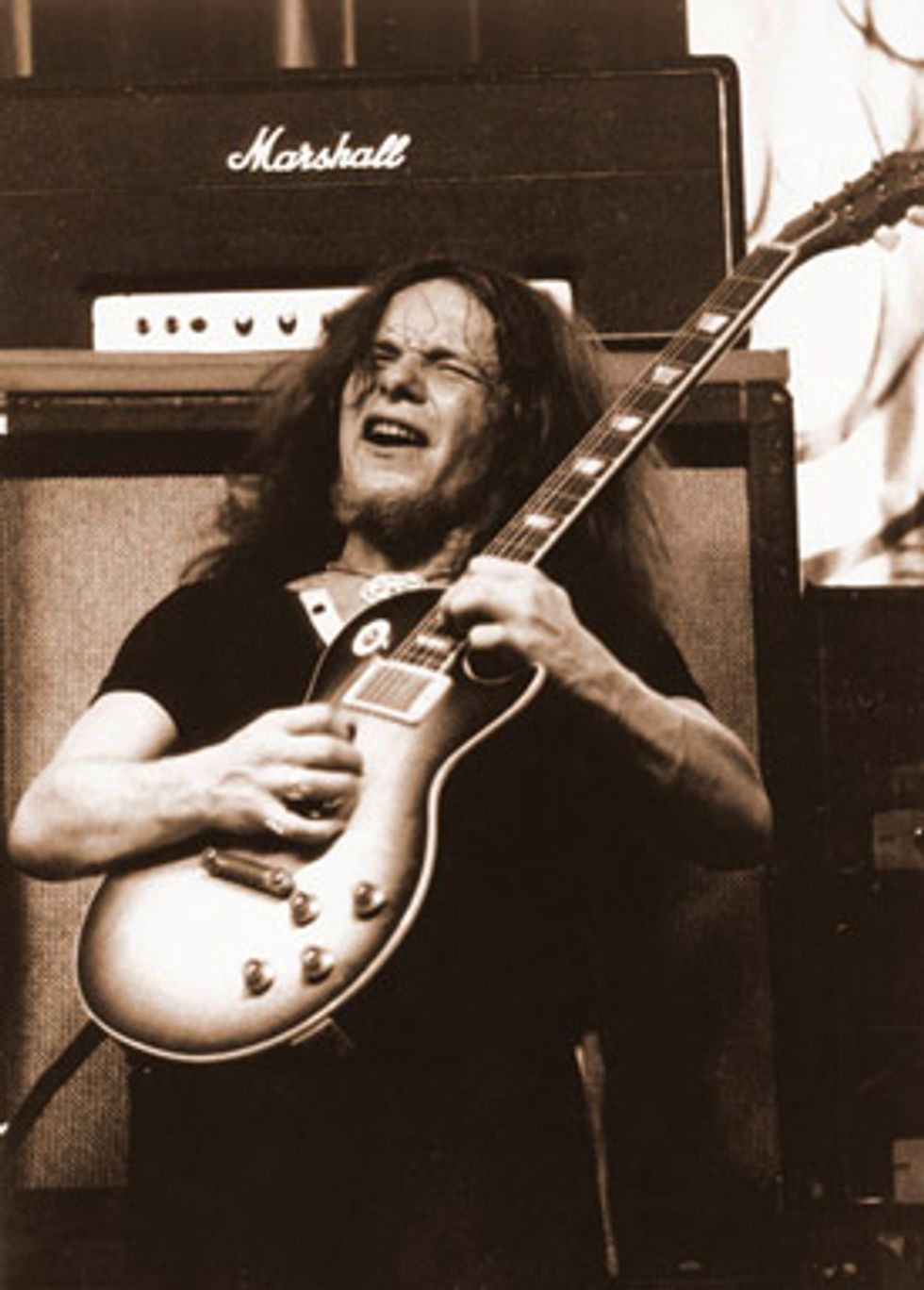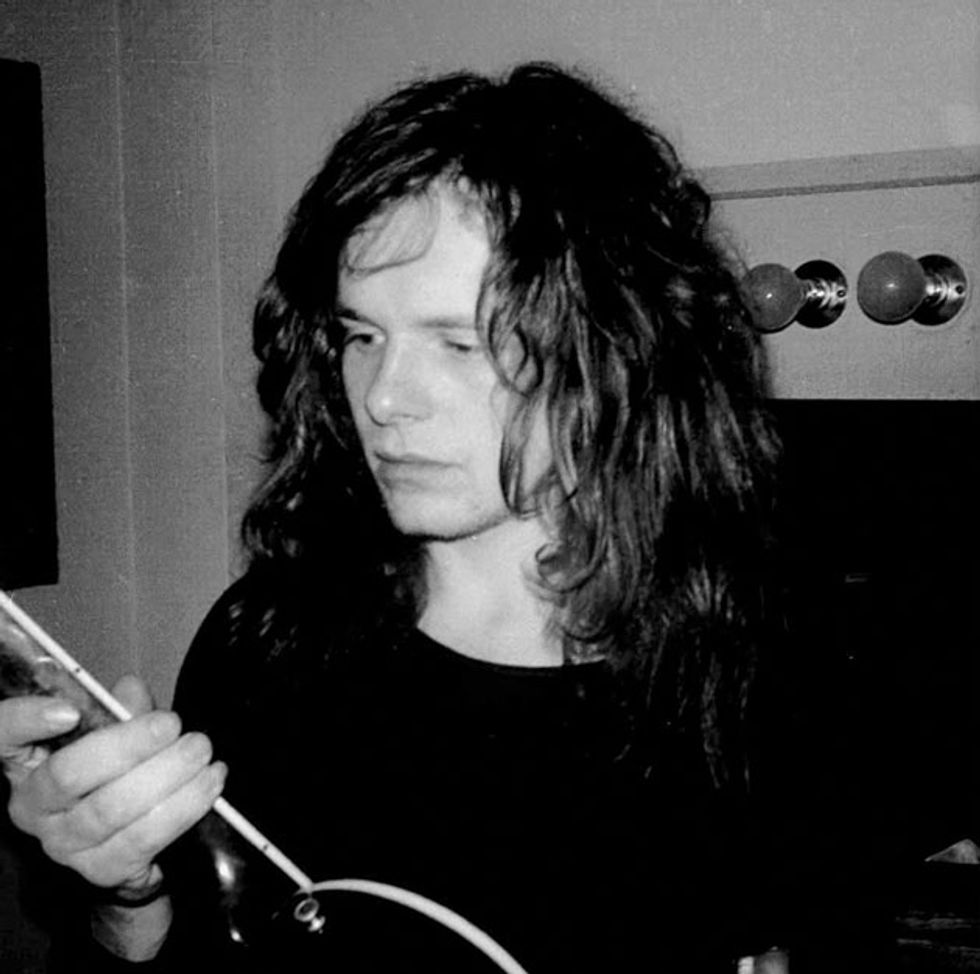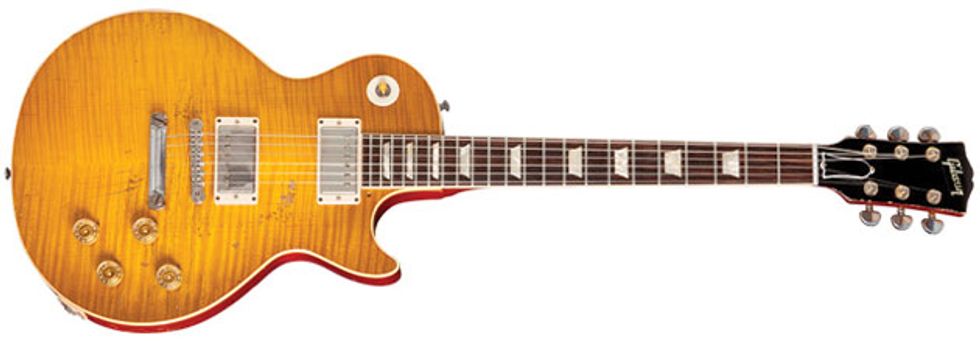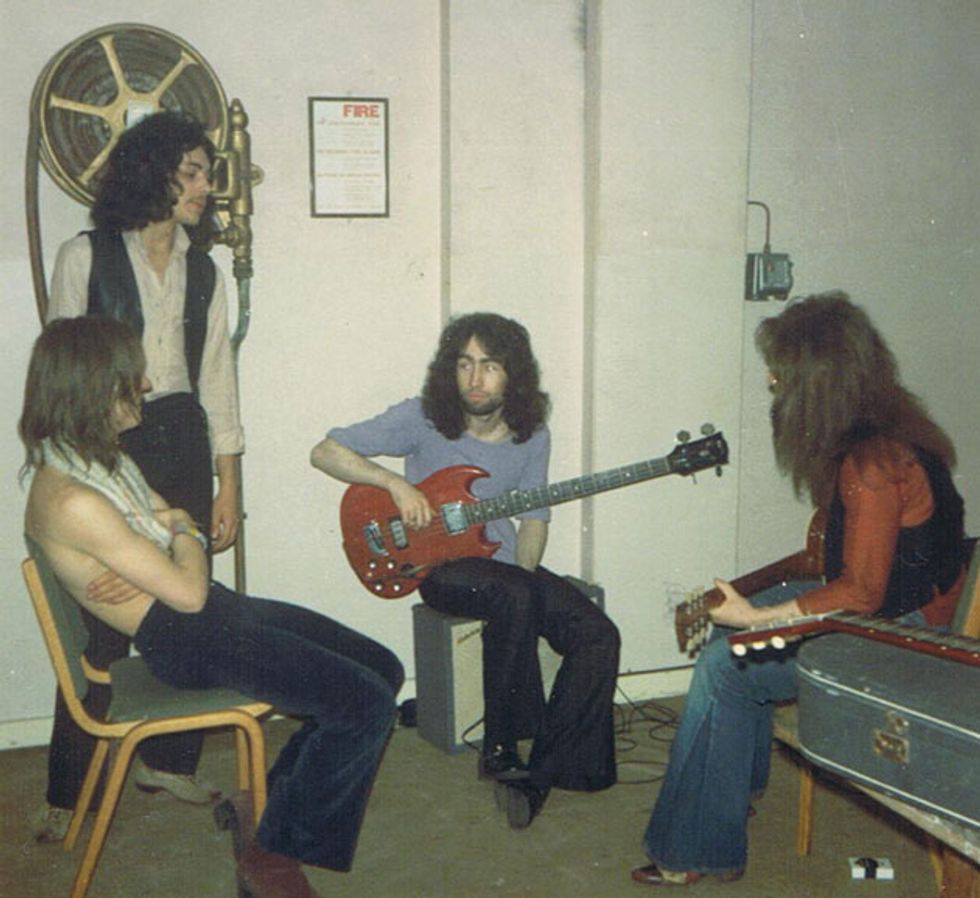In the 1960s, England was up to its eyeballs in white-boy blues bands. This was the golden age of the guitar player, when people like Clapton, Beck, and Page became recognized names the world over. But for every Cream, Yardbirds, or Led Zeppelin, there were scores of other groups working the same circuit, trying their damndest to break through. Free was such a band.
Between Paul Rodgers’ wailing, Simon Kirke’s tremendous backbeat, and the steady bass lines of Andy Fraser, Free had more than enough talent. And they had another weapon: Paul Kossoff, a player who brought it all together and elevated their music into the stratosphere.
Kossoff didn’t have the dexterity of Clapton, the finesse of Beck, or the bombast of Page, but he had an innate knowledge of how to do more with less, an instinct to make each note matter musically and emotionally. Sadly, Kossoff died from a drug-related heart attack at 25 during a flight from L.A. to New York, robbing the world of a unique talent. His memory lives on through his music and through the longtime anti-substance abuse efforts of the Paul Kossoff Foundation.
Chance Encounters
Paul Kossoff was born on September 14, 1950, in Hampstead, a London suburb. He was gifted with the performance gene from birth. His father, David, was a well-regarded film and television actor who would go on to win Most Promising Newcomer to Film at the 1955 BAFTA award ceremony.
Kossoff took to music early, commencing classical guitar lessons at age 10. “My dad said that if Paul wanted to play guitar, which he did of course, he had to learn to do it properly,” recalled Paul’s brother Simon in an interview with Gibson. “He went to a teacher in Golders Green, in North London, who taught him to read music, but he was partially dyslexic and wasn’t actually reading the music—he was mirroring her and remembering everything. He definitely had an innate talent for guitar.”
As much as Kossoff loved the guitar, the classical lessons grated on him, and he gave them up after a few years. His guitar sabbatical was short lived, however. Kossoff caught a performance by Eric Clapton at a John Mayall gig in 1965, and after seeing what Clapton was doing with the blues, his passion for the guitar was reignited. He resumed lessons, this time with noted session musician Colin Falconer.
Clapton became a looming figure in the young guitarist’s mind, and Kossoff went out of his way to emulate Slowhand. Kossoff’s first electric guitar was a cheap gold knockoff model made by the Italian manufacturer Eko that simply wouldn’t do. Looking to upgrade, Kossoff took a job at the venerable London music shop Selmer’s, where he came face to face with some of the day’s leading players.

Paul Kossoff kept it simple with a Les Paul, Super Lead heads, and 4x12 cabinets. He did as much to popularize the defunct ’burst line of LPs as Eric Clapton, Jimmy Page, and Keith Richards.
Photo by Graham Lowe
While manning the floor one day, he happened to meet a hot new prospect fresh off the plane from America: Jimi Hendrix. “He had an odd look about him and smelled strange,” Kossoff recalled in interview with Steven Rosen for Guitar Player in 1976. “He started playing some chord stuff like in ‘Little Wing,’ and the salesman looked at him and couldn’t believe it. Just seeing him really freaked me out. I just loved him to death. He was my hero.”
Kossoff was eventually able to purchase his first Gibson guitar. “I got myself a Gibson Les Paul Junior, which was the cheapest Gibson around at the time,” he said. “Then I had this obsession about getting a ‘real’ Les Paul after seeing Jeff Beck and Eric Clapton play them.” The real Les Paul he eventually acquired was a black 1954 Custom equipped with dual P-90 pickups, an instrument allegedly owned and played by Clapton himself. The guitar became his prized possession, and he spent hours bent over it, mastering the many blues licks and solos he’d come to love.
Kossoff started his own blues band called Black Cat Bones in 1966 and hit the London club scene. In the early years, the band had trouble breaking through to the mainstream, and the lineup changed often. Most importantly for Kossoff though, was the experience of playing the music he loved in front of people willing to hear it. Even more vital were the dates where Black Cat Bones supported another up-and-coming blues act called Fleetwood Mac. Kossoff spent many hours jamming with Fleetwood Mac founder/lead guitarist Peter Green and picking his brain, a significant experience in Kossoff’s development as a player.
In 1968 Kossoff and his band were in search of a new drummer when they came across Simon Kirke, who was in the audience at a Black Cat Bones gig after hearing through the grapevine that the group might be interested in his services. “I saw them and collared Paul Kossoff at the bar. I was overjoyed at being in a real live professional blues band,” Kirke told Jo Rishton for The Beat Goes On and On. “He was a bit of an artful dodger back then—he was funny, witty, full of life,” Kirke said of Kossoff in a separate interview with Get Ready To Rock.
With Kirke providing the backbeat, things started to move. In 1968 the group was given the plum assignment of backing acclaimed blues pianist Champion Jack Dupree for the record When You Feel the Feeling You Was Feeling, and subsequently joined him on a U.K. tour. After the tour Kossoff and Kirke decided to part with Black Cat Bones and form a new outfit all their own.
Photo courtesy of Lucy Piller.
Live Free, Play Hard
Vocalist Paul Rodgers and Kossoff ran in the same circles and had met many times, but hadn’t yet played together. When they finally did in 1968, it was a transformative experience. “The first official time I met him I was playing in a blues club called the Fickle Pickle in Finsbury Park,” Rodgers told Premier Guitar in a recent interview. “I had a blues band at the time called Brown Sugar. We used to do two 45-minute spots with a break in between. Koss came up for the second set and said, ‘I’d like to come for a jam.’ I said, ‘Have you got a guitar with you?’ and he said, ‘Yeah, I’ve got my Les Paul in the car.’
So he brought his guitar in and we jammed—a really heart-stopping jam. We did ‘Stormy Monday Blues,’ B.B. King, and a couple of other things, and it was like time stood still. It was such an amazing thing that when we came off stage I said to him, ‘Man, we have to form a band.’ The seeds of Free were born right there.”
The members of Free were remarkably young when they formed the group. Kossoff was 17, Rodgers and Kirke were 18, and bassist Andy Fraser was a mere 15. Despite this, each member already had a taste for the road after serving in other bands.
What bound Free more than anything else—especially Kossoff and Rodgers—was their unconditional love of the blues. “We used to listen to Albert King and B.B. King—especially B.B. King’s Live at the Regal and Albert King’s Born Under a Bad Sign—and we’d say that the two of us made one of them,” Rodgers recalls with a laugh. “The way B.B. or Albert would play and then answer themselves, we kind of picked up on that and consciously tried to emulate that and incorporate it into the music we did.”
Still without a band name, the quartet booked their first show at a modest club in London, where one of the kings of the nascent British Blues scene offered to help them out. “Alexis Korner had a band called Free at Last,” Simon Kirke said in The Beat Goes On and On. “When he saw us at the Nag’s Head in Battersea after our first rehearsal he suggested that, but we kind of whittled it down to Free.”
With a little help from Korner, Free inked a deal with Island Records. Their first album, Ton of Sobs, was in the canwithin six months of the band’s formation. For the sessions, Kossoff brought out a duo of Les Pauls, including a now-fabled late-era sunburst model, which was later stripped and painted black, as well as a black three-pickup custom. Along with the likes of Clapton, Page, and Keith Richards, Kossoff did much to popularize the defunct ’burst line of Les Pauls.
Gibson released the Paul Kossoff 1959 Les Paul Standard in early 2012 after gaining access to Kossoff’s legendary Les Paul, which was in the possession of Paul’s friend Arthur Ramm. Gibson created 100 hand-aged guitars and 250 models treated with their proprietary VOS process. Photo courtesy of Gibson
Tons of Sobs was recorded on a modest budget of £800 and was in some respects a recorded version of the band’s live set. “In those days, and particularly for the first album, we didn’t do what became the normal and block out a studio for a month at a time,” Rodgers recalls. “When we went in, we’d drop in, do a couple of tracks, and we’d have some band from South Ealing or somewhere peeping in the door going, ‘Are you guys finished yet?’”
After completing their first album, Free went on the road to try and make a name for themselves. Dwarfed by a column of Marshall stacks—Super Lead heads and 4x12 cabinets with bass speakers installed—Kossoff managed to make up for his diminutive height through sheer volume.
In addition to lead guitar duties, Kossoff was given another important task. “None of the rest of the band members had a driving license,” explains Rodgers. “Paul had started young and he had one, so he got the gig of driving us. He would drive us two or three hundred miles, do a couple of shows, and drive back. I used to sit in the front with him just to keep him awake.”
(Left to right) An unknown member of an opening band jams with Free bassist Andy Fraser, Free vocalist Paul Rodgers (holding Fraser’s bass), and Free guitarist Paul Kossoff in Croydon, England, in 1970. Photo by Lucy Piller
Not long after Tons of Sobs was released, the band was back in the studio working on its second record, the self-titled Free. This time the group was produced by the president of the label, Chris Blackwell. Things were much tighter, with the main songwriting duo of Rodgers and Fraser imposing a stricter framework.
Like the band’s debut, Free didn’t do much on the charts. Almost immediately after they finished recording, the group resumed its breakneck touring schedule, supporting the supergroup Blind Faith on its only American tour. Kossoff and Clapton became quite close, discussing the finer points of their respective techniques and even trading a couple of guitars. Clapton exchanged a 1959 Gibson Les Paul for Kossoff’s mid-’50s Custom. It was on this tour that Clapton supposedly tried to cop Kossoff’s famed vibrato technique, a tale confirmed by Rodgers. “I wasn’t privy to the actual conversation, but they did talk vibrato, that’s for sure,” he says.
As the ’60s gave way to the ’70s, Free reached a tipping point. They’d recorded two albums, experienced modest success, and performed a truly staggering number of live shows. But the band began to wonder where they would ever actually make it.
Then in June of 1970, Fire and Water hit the shelves with the force of an atomic blast. The record became Free’s breakthrough, led by the single “All Right Now,” which reached No. 2 on the U.K. charts and No. 4 in America. Just two months later, Free played the biggest gig of their career in front of an estimated 600,000 people as part of England’s Isle of Wight Festival.
With greater success came new tensions. Feeling pressure to prove that their success wasn’t a fluke, the band rushed to record its next album, Highway. Compared to Fire and Water, Highway was a commercial disappointment, only reaching No. 41 on the U.K. charts and 190 in America. Meanwhile, Kossoff, depressed by the death of his hero Jimi Hendrix, began self-medicating with Quaaludes.
Paul Kossoff’s Elements of Style
One of the most instantly recognized aspects of Paul Kossoff’s style is his spectacular vibrato, and it’s also one of the most difficult to replicate. “The vibrato of any player is your fingerprint,” explains Joe Bonamassa. “It’s just in your DNA. It’s your personality. It’s the timbre of your voice. Kossoff had a fast vibrato, but it was bluesy and soulful and fiery—kind of like B.B. King, who has a fast vibrato. It’s under control, but still passionate.”
Even if it’s true that a player’s vibrato is innate, that didn’t stop Kossoff from trying to refine his. As Paul Rodgers recalls, “He was always working on it. He was always trying to slow it down, get it just right.”
Another Kossoff trademark is doing more with less, making his guitar work within the confines of a group to produce the largest sound possible. “He wouldn’t just play an E chord,” Bonamassa says. “He would play a root/five, or reverse the root/five, so instead of having the root on the bassier end of the strings, he’d have it at the higher end. He came up with really interesting power chords that melded into the bass, so you’d have this guitar sound with a distorted bass tone, which created this incredibly heavy, simple midrange. A great example of that is ‘Fire and Water.’”
When Free decided to call it quits in 1971, Kossoff took it harder than anyone. “What I think we lacked was management,” posits Rodgers. “We lacked an older, wiser head to say, ‘Okay you guys, you’re under a lot of stress, you’ve done too many shows, you have this huge success all of a sudden, you need to take a break.’ We didn’t do that of course, and we just kind of exploded apart. We had been together for such a long time, living so close, seeking success, and when we finally reached it, there was so much pressure.”
After the breakup Kossoff collaborated with Free bandmate Kirke, along with Japanese bassist Tetsu Yamauchi and keyboardist John “Rabbit” Bundrick to release Kossoff/ Kirke/Tetsu/Rabbit. By this time Kossoff was in bad shape, as was apparent to all who knew him. “It was such a shame—he seemed to go down so fast,” recalls Rodgers. “I was mortified that the split-up of the band had affected him so deeply. He was almost gone to us at that point, because he was sort of off in this other world. It was such a shame because we all loved him so much, and we immediately dropped everything we were doing to try and put the band back together again so that we could put Koss back together.”
Heartbroken
The band managed to record a few albums during its brief resurgence: 1971’s Free Live and the studio efforts Free at Last and Heartbreaker in ’72 and ’73, respectively. Their tours, however, were hampered by Kossoff’s unreliability. The band called it quits for good in 1973.
Rodgers says the group was never able to recover from the turmoil of the earlier dissolution. “Splitting up was big news. It was official, and it was headline news: ‘Free Splits Up.’ All of a sudden, the spell was broken between us, and when we got back together again it just wasn’t the same. It was hard to rekindle what we had prior to all that.”
Kossoff immediately began working on his first solo record, Back Street Crawler, which featured guest appearances by his former Free bandmates as well as Alan White of Yes. The record was widely acclaimed but didn’t live up to the popularity of Free’s music. Kossoff then formed a band named Back Street Crawler and released The Band Plays On in 1975.
As the years wore on, Kossoff’s drug dependency worsened. “The big problem with Koss was he couldn't say no, and there were always people ready to take advantage,” Back Street Crawler manager Mike Green explained in an interview with Get Ready To Rock. “We were recording the first Back Street Crawler album at Olympic Studios, and every night I had to search everywhere, including the toilets, to make sure nobody had left any little presents for him. But no matter how thoroughly you searched there were times when he would still manage to get out of it. He wasn't addicted to anything in particular—he would take anything he could get his hands on.”
Back Street Crawler embarked on a headlining tour of the U.K. in 1975, but it was cancelled midway through when Kossoff developed a debilitating stomach ulcer. While getting treatment, Kossoff suffered a massive heart attack. It took the doctors 30 minutes to revive him.
Once out of the hospital, Kossoff went back on the road with his band, which subsequently recorded another album titled 2nd Street in 1976. In his weakened state, Kossoff was no longer able to perform to the level everyone expected, so most of guitar parts were played by session guitarist W.G. “Snuffy” Walden.
YouTube It
A live version of one of the great Free tracks that shows off Kossoff's vibrato, as well as his ability to shift the root note of a chord for a fuller sound.
All Right Now
Shortly after the release of 2nd Street, Back Street Crawler undertook a U.S. tour, which was again hampered by Kossoff’s condition. A bright spot occurred when Kossoff bumped into his former Free bandmates Kirke and Rodgers, now members of the supergroup Bad Company. “He was in town playing with his group when we were in LA,” remembers Rogers. “We went to visit him and had a big jam. I didn’t realize that he was in such bad shape at that point, because he seemed together. They told me afterwards that he pulled himself together for that night. That was the last time I saw him.”
On March 19, 1976, Kossoff boarded a plane in L.A. bound for New York, but he reach his destination. Midflight, Kossoff experienced a cerebral and pulmonary edema and died at the age of 25. “I was on tour with Bad Company when I heard the news,” says Rodgers. “It was just devastating.” Kossoff was laid to rest at Golders Green Crematorium, his headstone marked with a simple epitaph: “All Right Now.”
Kossoff’s father David set up the Paul Kossoff Foundation to raise awareness about substance abuse. Rodgers purchased one of Kossoff’s ’59 Gibson Les Pauls and later auctioned the instrument, donating the proceeds to the Foundation.
Gibson honored Kossoff in 2012 with a limited run of replicas of his later Free-era/Back Street Crawler Les Paul, debuted at NAMM by blues/rock guitarist Joe Bonamassa. “I inadvertently introduced Arthur Ram [current owner of the Paul Kossoff guitar] and Pat Foley [Head of Gibson Artist Relations] at a gig in Newcastle in 2009,” Bonamassa says. “I was just happy to help get the name Paul Kossoff out there.”
Paul Kossoff wasn’t the flashiest guitar player on the planet, and in the years since his passing, his name has been dwarfed by those of some of his contemporaries. He may not have been the fastest shredder, but he’s certainly among those legendary players who become one with the instrument. “One of the great things about Koss was that he played every note like his life depended on it,” declared Rodgers. “He was so passionate about his playing.” That passion shone through on record as well as onstage. It’s what set Paul Kossoff apart, and is the reason he should never be forgotten.











![Rig Rundown: Russian Circles’ Mike Sullivan [2025]](https://www.premierguitar.com/media-library/youtube.jpg?id=62303631&width=1245&height=700&quality=70&coordinates=0%2C0%2C0%2C0)

















